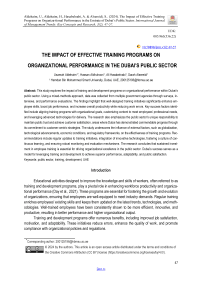The impact of effective training programs on organizational performance in the Dubai’s public sector
Автор: Usamah Aldehaim, Hassan Aldhuhoori, Ali Hasabelnabi, Sarah Alsereidi
Журнал: International Journal of Management Trends: Key Concepts and Research @journal-ijmt
Статья в выпуске: 2 vol.3, 2024 года.
Бесплатный доступ
This study explores the impact of training and development programs on organizational performance within Dubai’s public sec-tor. Using a mixed-methods approach, data was collected from multiple government agencies through surveys, interviews, and performance evaluations. The findings highlight that well-designed training initiatives significantly enhance employee skills, boost job performance, and increase overall productivity while reducing work errors. Key success factors identified include aligning training programs with organizational goals, customizing content to meet employees' professional needs, and leveraging ad-vanced technologies for delivery. The research also emphasizes the public sector's unique responsibility to maintain public trust and achieve customer satisfaction, areas where Dubai has demonstrated commendable progress through its commitment to customer-centric strategies. The study underscores the influence of external factors, such as globalization, technological ad-vancements, economic conditions, and regulatory frameworks, on the effectiveness of training programs. Recommendations include regular updates to training initiatives, integration of innovative technologies, fostering a culture of continuous learning, and ensuring robust monitoring and evaluation mechanisms. The research concludes that sustained investment in employee training is essential for driving organizational excellence in the public sector. Dubai’s success serves as a model for leveraging training and development to achieve superior performance, adaptability, and public satisfaction.
Public sector, training, development, UAE
Короткий адрес: https://sciup.org/170206427
IDR: 170206427 | УДК: 005.963(536.22) | DOI: 10.58898/ijmt.v3i2.47-57
Список литературы The impact of effective training programs on organizational performance in the Dubai’s public sector
- Binstead, D., & Stuart, R. (1979). Designing Reality into Management Learning Events I: Towards Some Working Models. Personnel Review, 8(3), 12-19. DOI: https://doi.org/10.1108/eb055385
- Healy, P. (2001). Training and Public Sector Reform: An Integrated Approach. Public Administration and Development, 21(4), 309-319. DOI: 10.1002/pad.188
- Ramirez, E. (2008, January 10). This bus is plugged in: Wi-Fi Arkansas kids’ study on their commute. US News and World Report. https://www.usnews.com/articles/education/elearning/2008/01/10/this-bus-isplugged- in.html
- Chethana, K. M., & Noronha, S. D. (2023). A Review of the Strategies Used in the IT sector for Employee Training and Development. International Journal of Case Studies in Business, IT, and Educa-tion, 7(2), 141–155.https://doi.org/10.47992/ijcsbe.2581.6942.0264
- Day, D. V., Bastardoz, N., Bisbey, T. M., Reyes, D. L., & Salas, E. (2021). Unlocking Human Potential through Leadership Training & Development Initiatives. Behavioral Science & Policy, 7(1), 41–54.https://doi.org/10.1177/237946152100700105
- Khalfan Almehairbi, P. Arunprasad, & Zakaria El Hathat. (2023). Role of open innovation and strategy on SMEs in Dubai: review and theoretical framework. Benchmarking: An International Jour-nal.DOI: https://doi.org/10.1108/bij-04-2022-0234
- McCourt, W., & Sola, N. (1999). Using training to promote civil service reform: Tanzanian local government case study. Public Administration and development, 19(1), 63-75. DOI: https://doi.org/10.1002/(SICI)1099-162X(199902)19:1%3C63::AID-
- PAD55%3E3.0.CO;2-F
- Sahinidis, A., & Bouris, G. (2008). Employee perceived training effectiveness relationship to em-ployee attitudes. Journal of European Industrial Training, 32(1), 63-76. DOI: 10.1108/03090590810846575
- Mentz, J. C. N. (1997). Personal and institutional factors in capacity building and institutional development. European Center for Development Policy Management.
- Ownes, P. L. (2006). One More Reason Not to Cut Your Training Budget: The Relationship between Training & Organizational Outcomes. Public Personnel Management, 35(2), 163-172. DOI: 10.1177/009102600603500205
- Mdhlalose, D. (2020) An Evaluation of the Impact of Training and Development on Organisational Performance: A Case Study of the Gauteng Provincial Department of Economic Development. Journal of Human Resource and Sustainability Studies, 8, 48-74. doi: 10.4236/jhrss.2020.81004.
- Al-Nuseirat, M., & Biygautane, M. (2014). Effectiveness of Training Programs in Dubai’s Public Sector. International Journal of Public Administration, 37(8), 543–558.https://dedi1968.files.wordpress.com
- Leuhery, F. (2024). The Role of Technology in Employee Training and Development: A Systematic Review of Recent Advances and Future Directions. Management Studies and Business Journal (PRODUCTIVITY), 1(3), 369-385.DOI: https://doi.org/10.62207/jmnzaw55
- Baroudi, S., Abdulaal, D., & Rampur, M. (2018). Training Effectiveness During Technological Changes in Dubai-Based Companies: Perspectives from Managers and Employees. Development in Learning Organizations an International Journal, 32(3), 1-3. https://doi.org/10.1108/dlo-10-2017-0085
- Chen, Z. (2022). Artificial intelligence-virtual trainer: innovative didactics aimed at personalized training needs. Journal of the Knowledge Economy, 14(2), 2007-2025. https://doi.org/10.1007/s13132-022-00985-0
- Chow, N. and Yeh, I. (2022). Correlation between learning motivation and satisfaction in syn-chronous on-the-job online training in the public sector. Frontiers in Psychology, 13. https://doi.org/10.3389/fpsyg.2022.789252
- Grassini, S., Laumann, K., & Skogstad, M. (2020). The use of virtual reality alone does not promote training performance (but sense of presence does). Frontiers in Psychology, 11. https://doi.org/10.3389/fpsyg.2020.01743


